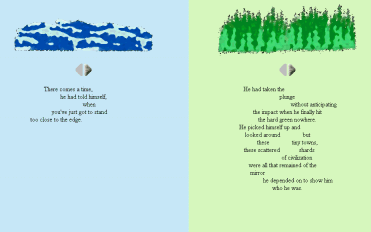New River 8 Visited
by Gerhard Rolletschek, Munich
mail: gerhard@rolletschek.com
New River 8 can be found at www.cddc.vt.edu/journals/newriver/
Introduction
Hypertext poetry has come a long way ... Read more
David Herrstrom: Sorting Things Out
To classify and thus simplify the multiplicity of objects ... Read more
Robert Kendall: A Study in Conveyance
|
Much closer to print media poetry ... is A study in conveyance. Yet it broadens the range of written poetry by making use of simple, but quite subtle hypertextuality. |
[a screenshot] |
|
The screen is divided in two columns, the left one having a blue background and a picture resembling the sea, the right one a green background with an image of a forest. There are two poems, one on the left and one on the right through which stanzas one can navigate by using arrow-buttons shaped as step-stones. It's quite a simple setting. Just like the way the plot of these genre objectif – poems begins. | |
|
The left one introduces a man standing close to a cliff who is pondering about whether he should give himself the chance to fall down and be reborn by being washed away. |
rocked to hard dreaming in |
Containing more epic elements, the poem on the right unfolds the development of a story. It is about a man and a woman escaping from civilisation to the wilderness of forrests in the north. An elope that seemed to allow preserving themselves and their identities, it is an ambigous journey. The core of one's personality is prone to be consumed, the commerical metaphors (Goods, Consumable) hint at the destruction of a romantic notion of impenetrable identity. |
where your Real Goods,
|
From the very beginning the man doubts that the woman's promise of authentic living can be fulfilled in the wilderness of the woodlands. The external measures defining him may be left behind |
were all that remained of the |
, but at the cost of isolation. |
The place produced its resonant loneliness like legal tender |
|
The stories delivered in the poems interweave. Both turn out to tell situations of transition both display the hope of reducing oneself to a basic unity of existence and yet show the fragility or even futility of this hope. |
stand |
acutely actual, Finally | |
|
One may not hope for undivided presence. The simplicity of things, which manifests in the plain navigation, is an illusion. Yet in the end it is impossible to tell if this knowledge itself is valid. The transitional setting of the poems itself loses its clarity. The stories of crossing the borderline, which the poems announced, will not be told, as this borderline loses significance. Even the division of the virtual writing-space dissolves. When one reaches the end of the poems, the background-colors and the images on top have become the same.
|
warm sand |
he realized he would never | |
The hypertextuality deployed in the first stanzas eliminates itself: By following the links, the two layers of the document become one. This is manifested both in the text and in the graphical arrangement. The poems' endings deliver us more or less the same notion of indecisiveness, just as the difference of design is flattened out. A setting of an interweaving multiplicity of texts is reduced to one of mere reproduction. ... back |
Joel Weishaus: Inside the Skull-houseA quite different approach is that of Joel Weishaus ... Read more |
